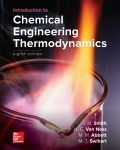
(a)
Interpretation:
For a process in which an ideal gas with
Concept Introduction:
For isothermalcompressionprocess,
And
(a)
Answer to Problem 3.21P
The values of values of
Explanation of Solution
Given information:
It is given that
For isothermal compression process,
“-” sign shows that heat is releasing, and volume is decreased on applying of work done on it.
(b)
Interpretation:
For a process in which an ideal gas with
Concept Introduction:
The total amount of
For step 1B adiabatic compressionprocess,
And
For step B2 constant pressureprocess,
And
(b)
Answer to Problem 3.21P
The values of values of
Explanation of Solution
Given information:
It is given that
Since initial and final temperature is same in the process because
So
So
So, we only need to do calculations for
For step 1B adiabatic compressionprocess,
For step B2 constant pressure process,
For whole process,
(c)
Interpretation:
For a process in which an ideal gas with
Concept Introduction:
The total amount of
For step 1C adiabatic compressionprocess,
And
For step C2 constant volume process,
(c)
Answer to Problem 3.21P
The values of values of
Explanation of Solution
Given information:
It is given that
Since initial and final temperature is same in the process because
So
So
So, we only need to do calculations for
For step 1Cadiabatic compressionprocess,
For step C2 constant volume process,
For whole process,
(d)
Interpretation:
For a process in which an ideal gas with
Concept Introduction:
The total amount of
For step 1Dheating at constant volumeprocess,
For step D2 cooling at constant pressureprocess,
(d)
Answer to Problem 3.21P
The values of values of
Explanation of Solution
Given information:
It is given that
Since initial and final temperature is same in the process because
So
So
So, we only need to do calculations for
For step 1D heating at constant volumeprocess
For step D2 cooling at constant pressure process,
For whole process,
(e)
Interpretation:
For a process in which an ideal gas with
Concept Introduction:
The total amount of
For step 1Ecooling at constant pressureprocess, volume decreases, heat will be released and negative and work done is positive.
For step E2 heating at constant volumeprocess, pressure increases
(e)
Answer to Problem 3.21P
The values of values of
Explanation of Solution
Given information It is given that
Since initial and final temperature is same in the process because
So
So
So, we only need to do calculations for
For step 1E cooling at constant pressureprocess,
For step E2 heating at constant volume process,
heating at constant volume causes increase in pressure inside vessel
For whole process,
Want to see more full solutions like this?
Chapter 3 Solutions
EBK INTRODUCTION TO CHEMICAL ENGINEERIN
 Introduction to Chemical Engineering Thermodynami...Chemical EngineeringISBN:9781259696527Author:J.M. Smith Termodinamica en ingenieria quimica, Hendrick C Van Ness, Michael Abbott, Mark SwihartPublisher:McGraw-Hill Education
Introduction to Chemical Engineering Thermodynami...Chemical EngineeringISBN:9781259696527Author:J.M. Smith Termodinamica en ingenieria quimica, Hendrick C Van Ness, Michael Abbott, Mark SwihartPublisher:McGraw-Hill Education Elementary Principles of Chemical Processes, Bind...Chemical EngineeringISBN:9781118431221Author:Richard M. Felder, Ronald W. Rousseau, Lisa G. BullardPublisher:WILEY
Elementary Principles of Chemical Processes, Bind...Chemical EngineeringISBN:9781118431221Author:Richard M. Felder, Ronald W. Rousseau, Lisa G. BullardPublisher:WILEY Elements of Chemical Reaction Engineering (5th Ed...Chemical EngineeringISBN:9780133887518Author:H. Scott FoglerPublisher:Prentice Hall
Elements of Chemical Reaction Engineering (5th Ed...Chemical EngineeringISBN:9780133887518Author:H. Scott FoglerPublisher:Prentice Hall
 Industrial Plastics: Theory and ApplicationsChemical EngineeringISBN:9781285061238Author:Lokensgard, ErikPublisher:Delmar Cengage Learning
Industrial Plastics: Theory and ApplicationsChemical EngineeringISBN:9781285061238Author:Lokensgard, ErikPublisher:Delmar Cengage Learning Unit Operations of Chemical EngineeringChemical EngineeringISBN:9780072848236Author:Warren McCabe, Julian C. Smith, Peter HarriottPublisher:McGraw-Hill Companies, The
Unit Operations of Chemical EngineeringChemical EngineeringISBN:9780072848236Author:Warren McCabe, Julian C. Smith, Peter HarriottPublisher:McGraw-Hill Companies, The





